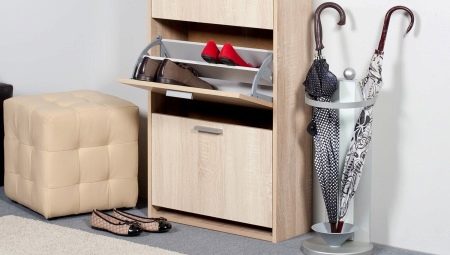Making out the hall, we must not forget about such a necessary interior item as a shoe rack. Having chosen not only a beautiful, but also a practical design, it will be possible once and for all to solve the problem with a mess on the floor.
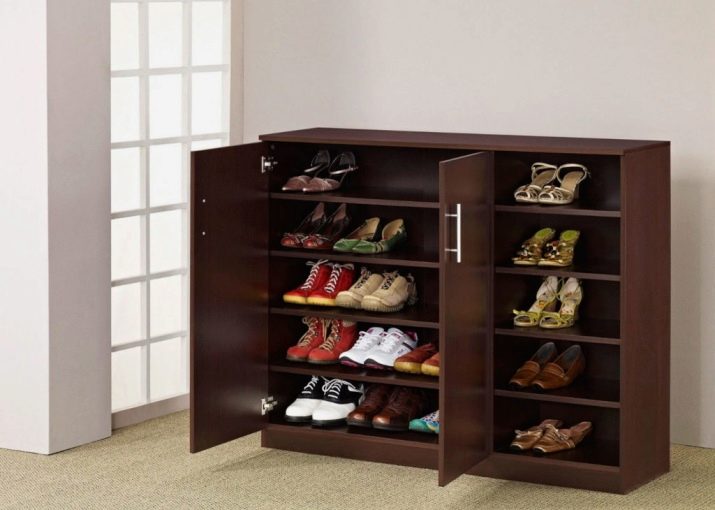
Features
The shoe rack in the hallway is selected in accordance with the preferences of the owners, as well as the size of the room.
For example, if the footage of the room is small, then it makes sense to purchase an open structure that combines the rack itself, the surface for the seat, the hanger for outerwear and the shelf for hats and caps.
In the case when space allows, then you can take a separate stand, which will only perform the function of storing shoes.
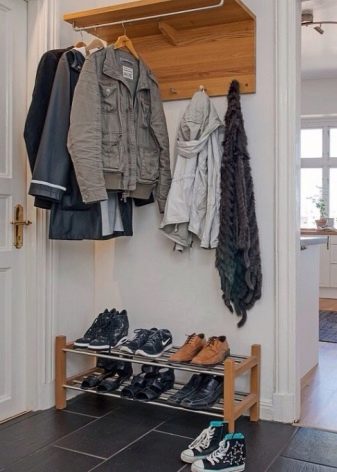
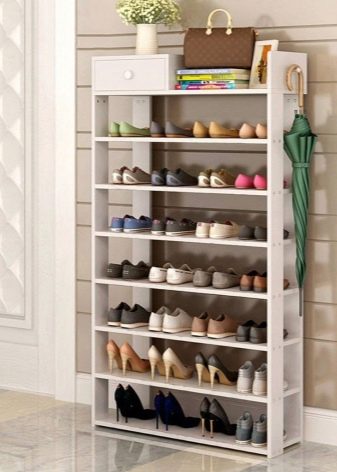
In fact, the shoe rack is a rack consisting of several tiers. It has compactness and durability, which makes it possible to intelligently use the free space of the hallway and make it more accurate. More complex models are also more functional - they have the ability to place bags, umbrellas, keys or other items.
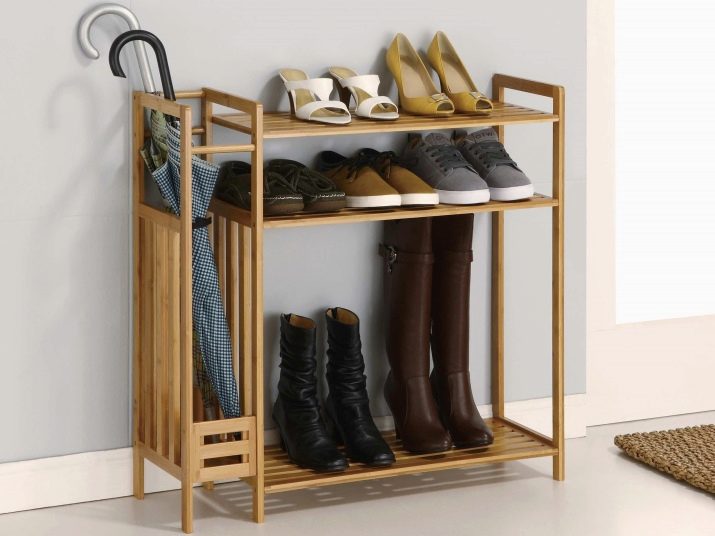
It is important to mention that the shoe rack requires special operating rules, especially open racks.
First of all, we are talking, of course, about the purity of the interior. Besides, it is important that the shoes are placed on a shelf in a row to avoid bending.
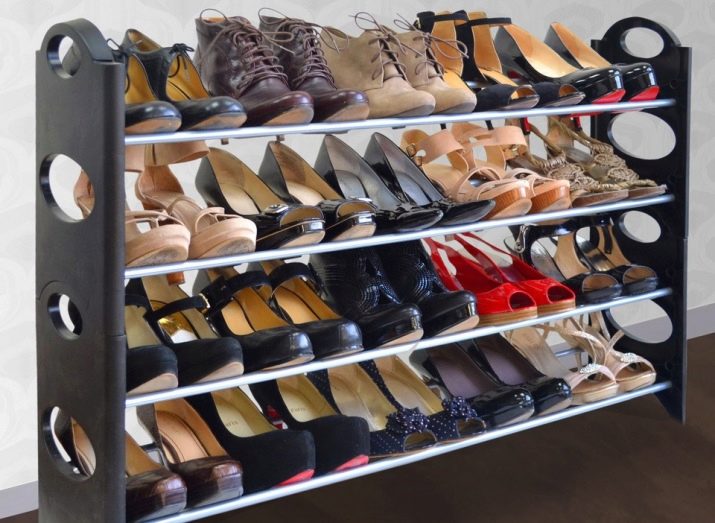
If the shelves are made of wood, then they should not be put on wet shoes only from the street. Boots and boots should be dried so that excessive moisture does not harm the condition of the material.In the case when direct storage is carried out inside the mesh baskets, then before placing the shoes inside it should be shaken off from mud clods.
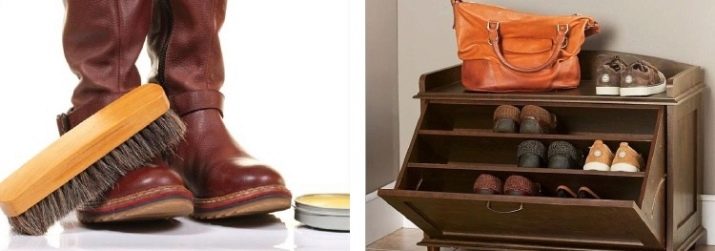
Types of designs
Shoe racks consist of a frame and several shelves. Depending on the type of frame, open and closed storage systems are distinguished. Usually, an open stand consists of a pair of three shelves, more panels are much less common.
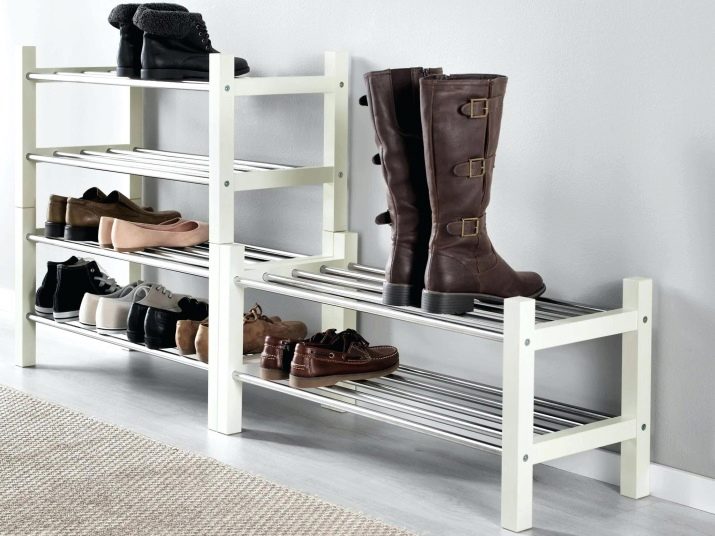
The top shelf can be a soft or hard seat, or just be different from the rest, thereby making it possible to store bags, gloves and other items on it.
Open coasters provide easy access to shoes, as there are no doors.
Shelves located at different levels make it possible to store shoes of different heights.
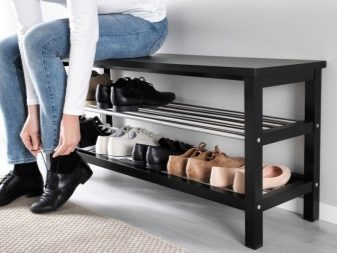
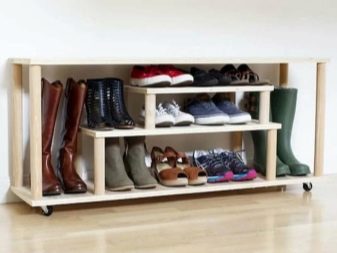
Closed coasters imply that content is hidden behind doors. Shoes can be stored on ordinary or folding shelves, as well as in wicker baskets.
The main advantage of such models is the protection against ingress of dust.
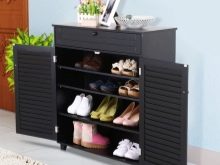
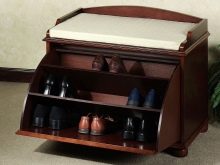
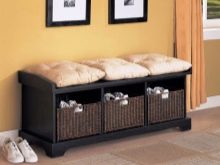
Frames are solid or collapsible, which usually depends on the material - for example, heavy forged racks can not be disassembled.
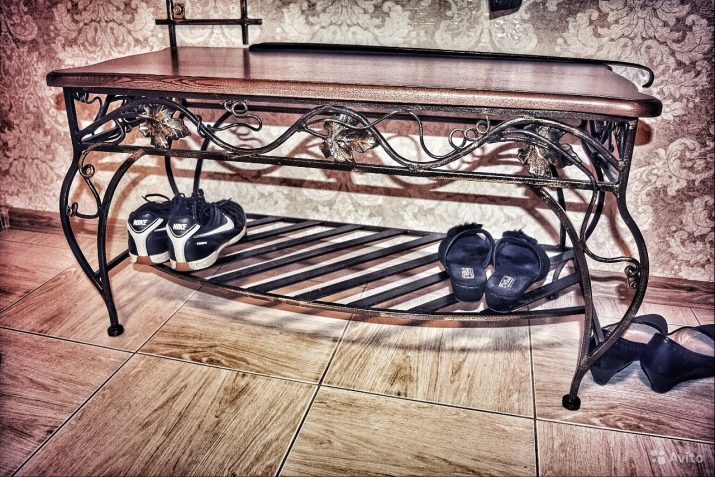
It is customary to make storage shelves themselves either mesh, and place a pan for draining dirt at the bottom, or immediately in the form of a pallet.
The mesh design is more welcome, as it additionally carries out the ventilation of shoes.
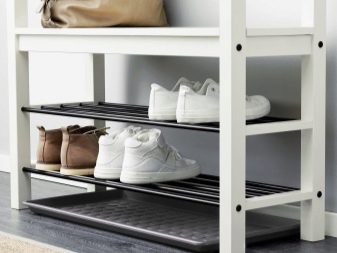
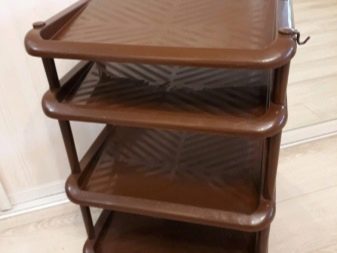
In general, the main types of stands are the classic shelving with shelves, a rack with doors and a structure with a seat, which is a box with a lid on which you can sit.
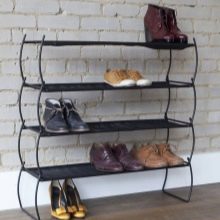
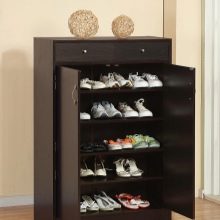
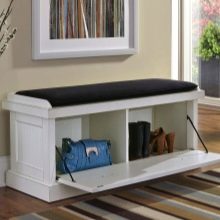
Besides, some experts attribute to them special hangers-holders for storing shoes. This design with the help of fastening elements can be placed on any vertical surface, saving space in the hallway.
However, it is only suitable for shoes with low shafts.
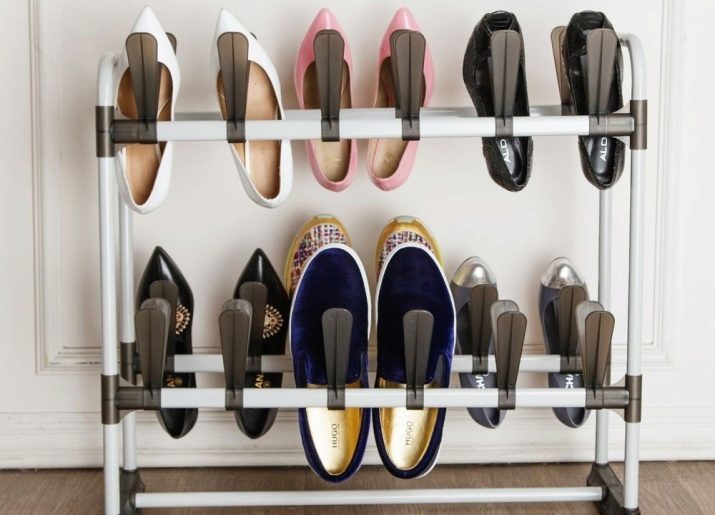
Materials of manufacture
There are 4 basic materials for making shoe racks: plastic, wood, metal and rattan. The choice of this or that material depends on both financial capabilities and the existing interior style. Plastic models are the cheapest. Although before the appearance of the stand was quite plain, today more stylish models are produced.
Plastic is easy to care for, but it is not particularly durable and reliable.
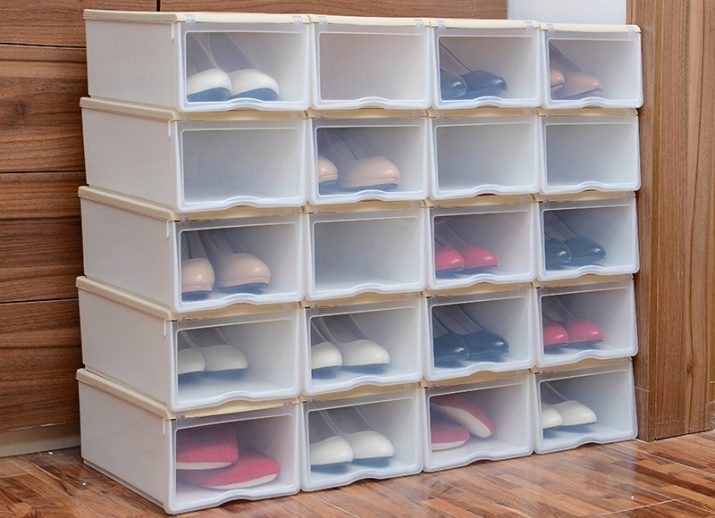
The metal stand, on the contrary, has the necessary strength. Quite often, for the manufacture of an element, metal is combined with wood to provide additional shelves.
Existence of a special covering against corrosion allows to use a rack even for storage of street shoes.
The metal model looks very beautiful, and therefore its price is quite high. Another relative disadvantage of such furniture can be called a lot of weight.
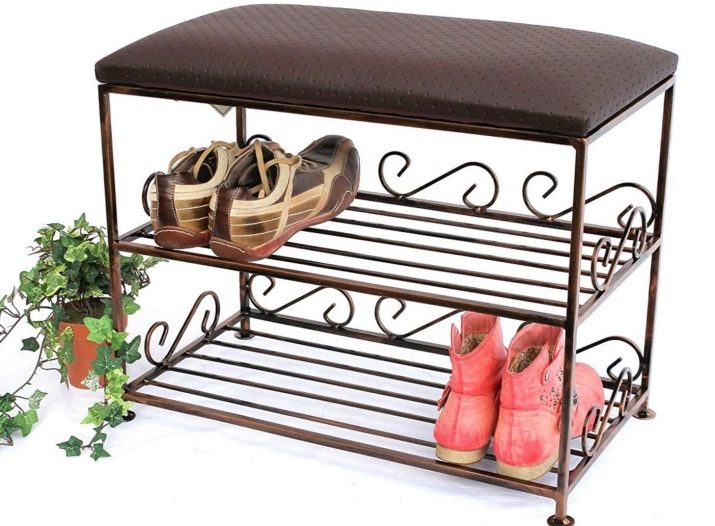
A wooden shoe rack is usually made in the form of a small cabinetequipped with either inclined or horizontal shelves. Doors protect the shoes from dust and provide the design with an attractive appearance.
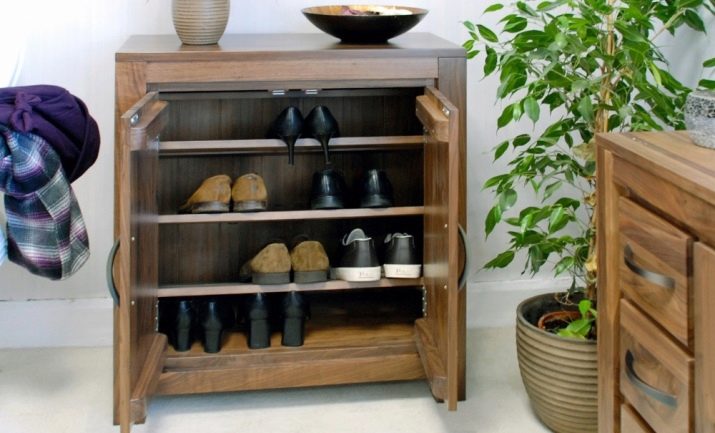
However, there are simple open models. Natural wood is necessarily pre-treated with special compounds to protect against moisture, pests and mold.
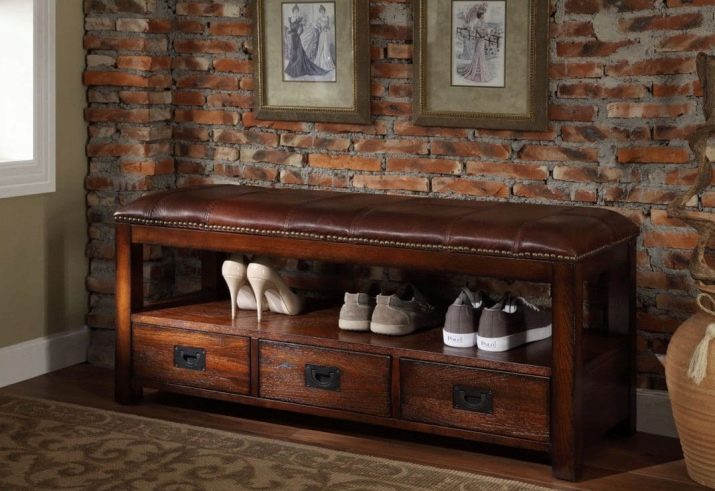
Wooden structures can be quite expensive, so an alternative such as MDF is often used.
The lower cost and the presence of a wide color palette explains the popularity of this material. MDF coasters are also treated with water-repellent substances.
Both wood and MDF fit perfectly into almost any interior and have an attractive appearance.
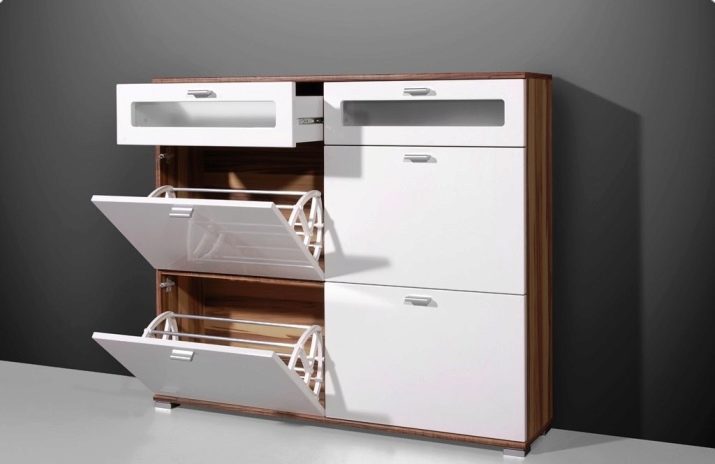
Rattan furniture is environmentally friendly and lightweight both in terms of weight and appearance. Nevertheless, such coasters are quite durable and able to serve for many years with proper use.
However, rattan coasters do not always undergo treatment against moisture, and therefore this issue will have to be clarified at the time of purchase.
Otherwise, storing street shoes this way will not work.
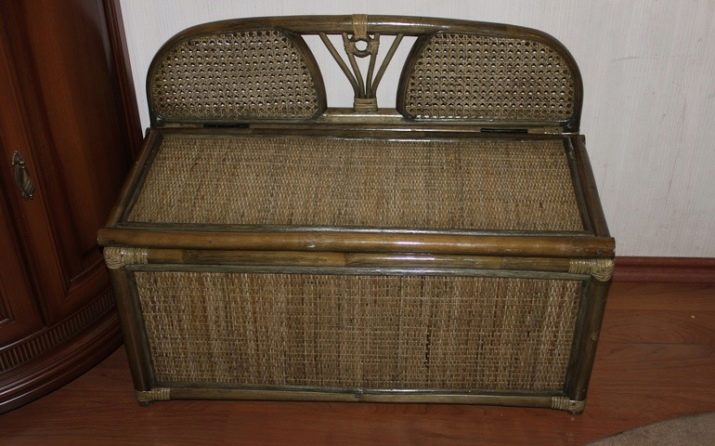
Racks made of various materials are suitable for different interior styles. For example, the tree fits perfectly into the classic, oriental interior, modern style. Coarse and as if untreated wood looks better in the direction of rustic or country, especially if you combine it with artificially aged metal.
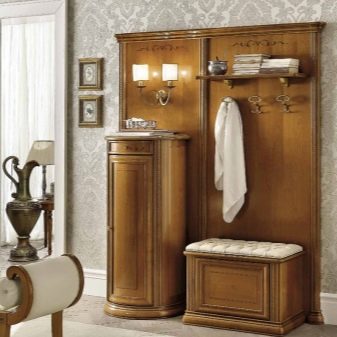
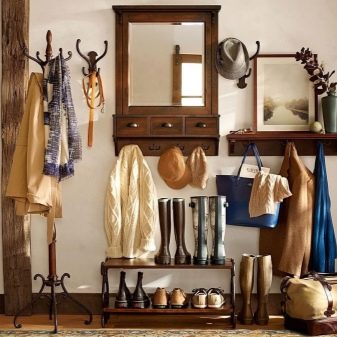
For a loft style, the combination of metal and wood should already be “younger”, but the holders or legs can be replaced with real tubes. Plastic looks good in styles such as minimalism and high-tech. Rattan coasters are usually installed in eco-interiors.
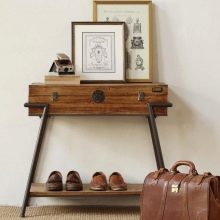


How to choose?
When choosing a shoe rack, there are three important factors to consider. Mainly, the design should be practical and appropriate to its intended functions. For example, it is important to provide a rack for street shoes with a ventilation system and ideally equip with open shelves.
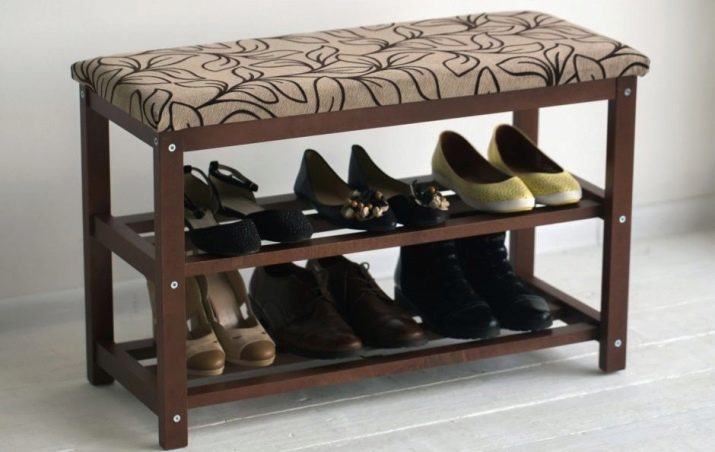
The size should allow you to place all the pairs that are present in everyday life, but organically fit into the footage of the room. As an option, just for shoes from the street a couple of shelves will be enough, but for storing the entire shoe wardrobe it is still better to allocate a separate cabinet with suitable storage systems.
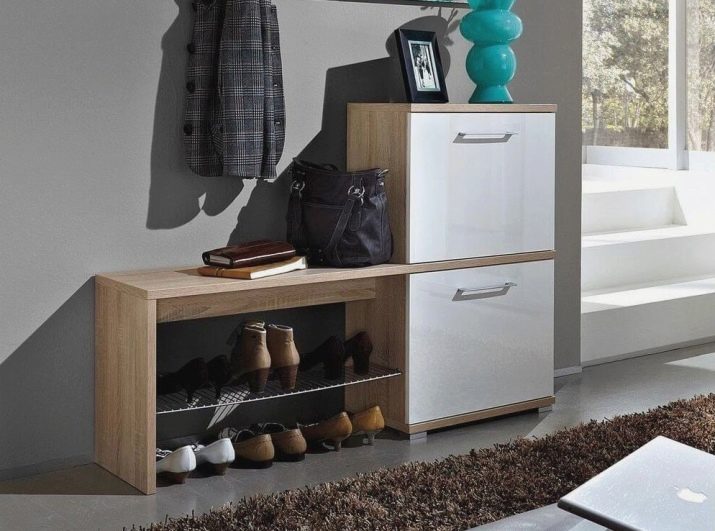
The esthetics of the stand are also important. It should harmoniously fit into the everyday interior, as well as meet the preferences of the inhabitants of the apartment or house.
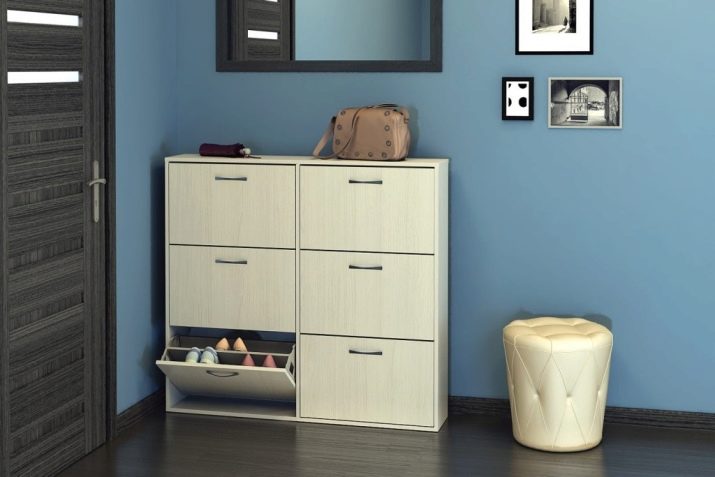
Finally, one has to consider the financial factor. From what amount the buyer has, it depends on what material the stand will be made of, whether it will have an original design.
Just before buying, it is important to evaluate the quality of the hardware and the thickness of the panels used to place the shoes.
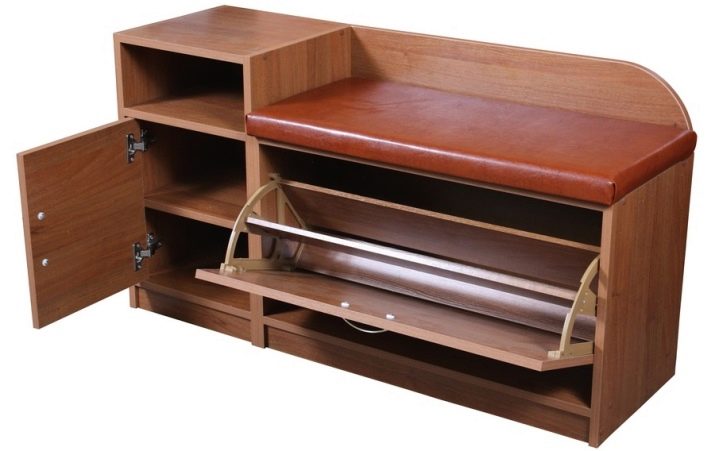
Location
It is most convenient to place the stand in the so-called “dirty” zone, where the process of putting on and removing shoes takes place. Boots and boots will always be at hand, and you can not be afraid to accidentally get your feet dirty, just heading to the bathroom.
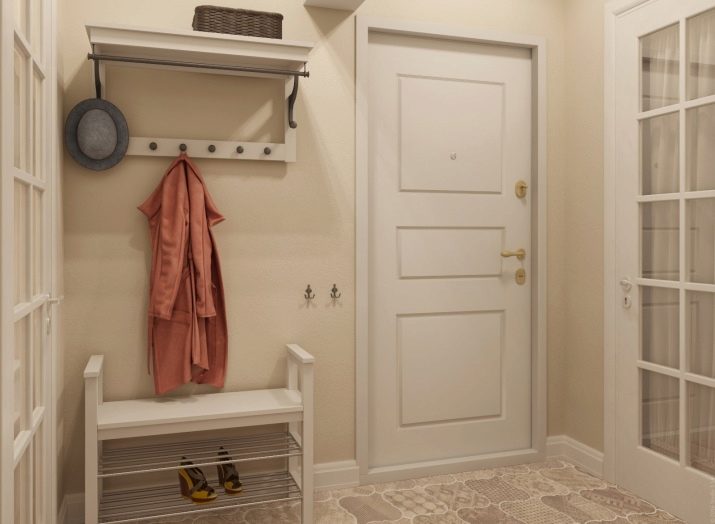
If the design is selected with doors, then they should open quietly and not interfere with people in the hallway.
The rack should not block any walkways, and should not be close to the exit. It would be nice to have a hook with a spoon for putting on shoes nearby.
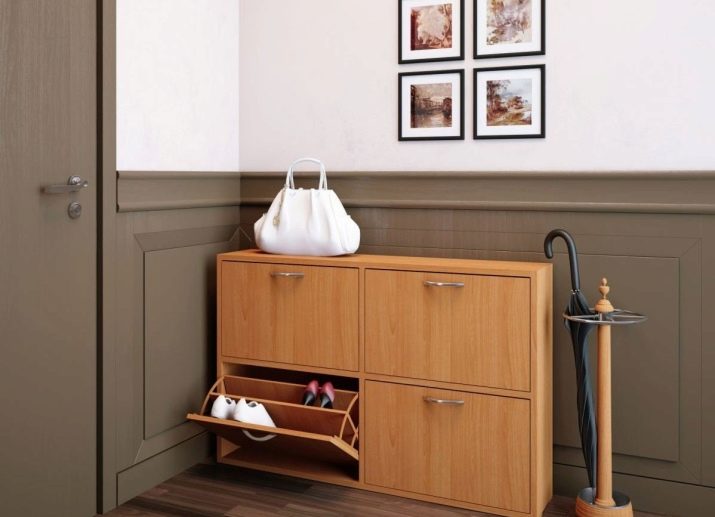
Being guided by the sizes, it is important not to forget about the located sockets, switches and plinths, "hiding" free centimeters.
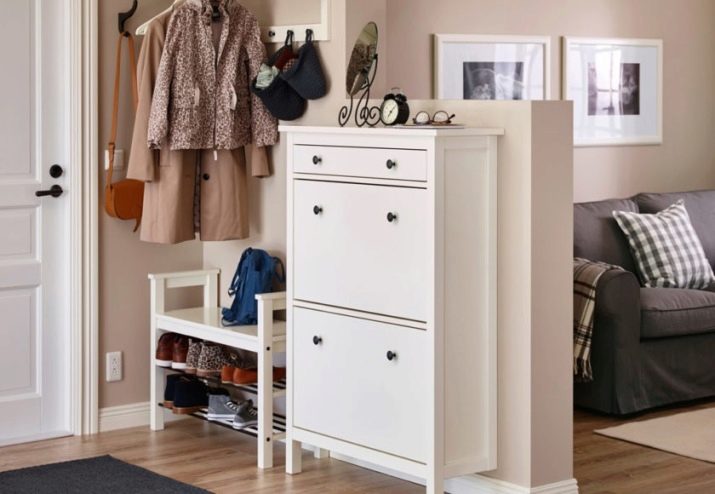
Good examples in the interior
Sometimes the entrance hall is too small to accommodate a stand for shoes, a stool and a hanger separately.
Therefore, it would be most logical to order a multifunctional design, arranging everything as compactly as possible.
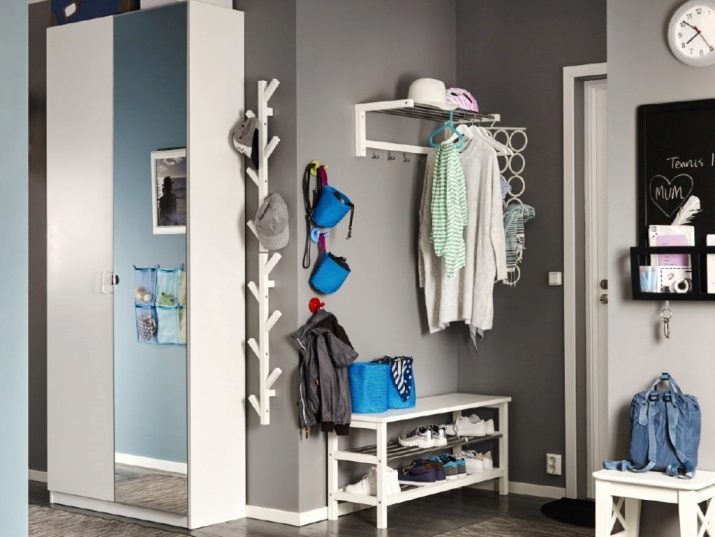
In the Scandinavian-style entrance hall, the walls are painted in a calm light gray shade, and on the floor there is a laconic black and white tile. In this case, the shoe rack is a structure made of wood and metal. Its top is a wooden panel, painted in white, which can be used for small items or sitting while putting on shoes.
The shoes themselves are stored on metal shelves with holes located slightly at an angle.At the top of the rack is a hanger that allows you to store outer clothing and place hats at the top. Thus, in a small space everything that should be in the hallway is placed.
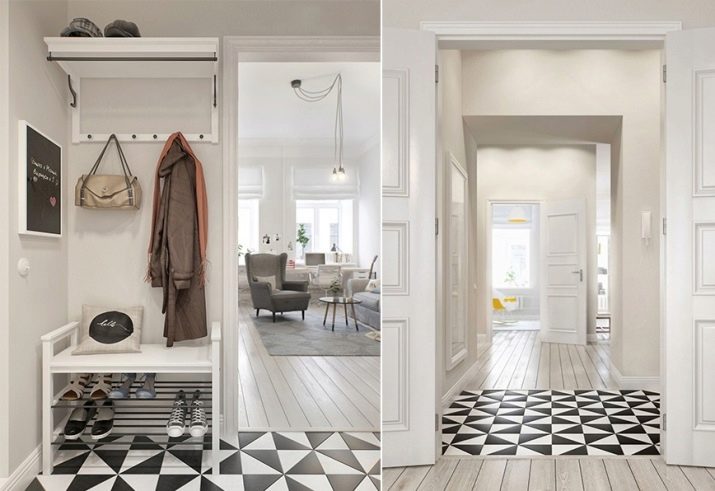
In a country house, the same laconic design can be complicated. The shoe rack finds a soft seat at the top. The place of shelves is occupied by woven square-shaped boxes. The same containers, but of a lower height, are also placed above the hanger for outerwear. I must say that there is a chest of drawers nearby, at the bottom of which there is the same wicker box, and at the top there is a storage area with a door.
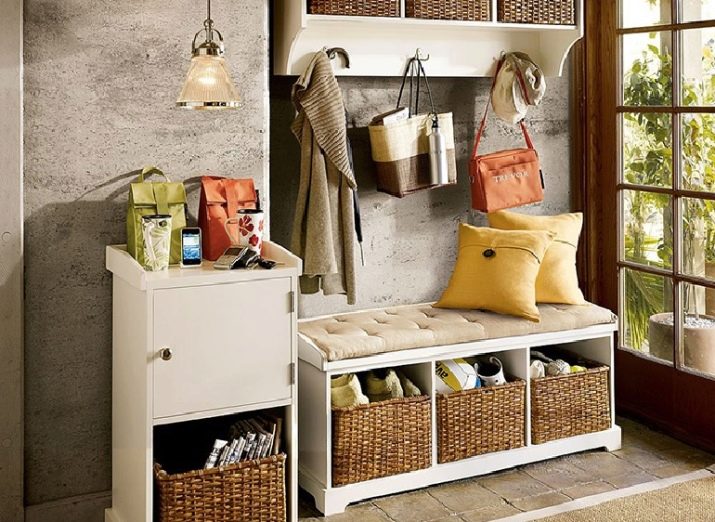
In a classic interior with ethnic or eco-style, the shoe rack is made of rough dark wood. Below is a shelf for shoes, just above two drawers, and on top you can sit, store some accessories or even place decor items, such as living plants in clay pots. The interior of the hallway is complemented by a hanger for outerwear made of darker wood, a poster and a wicker vase with floral elements inside.
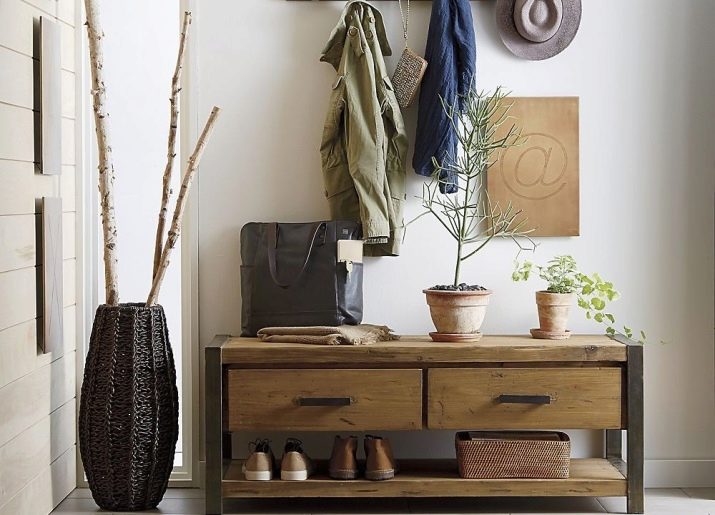
By the way, if the open stand chosen for the hallway seems too ugly, then you can simply put it under a laconic table made of white wood. Thus, a multifunctional composition will be created, the highlight of which will be attached to the photo frames placed on top and a lighting device.
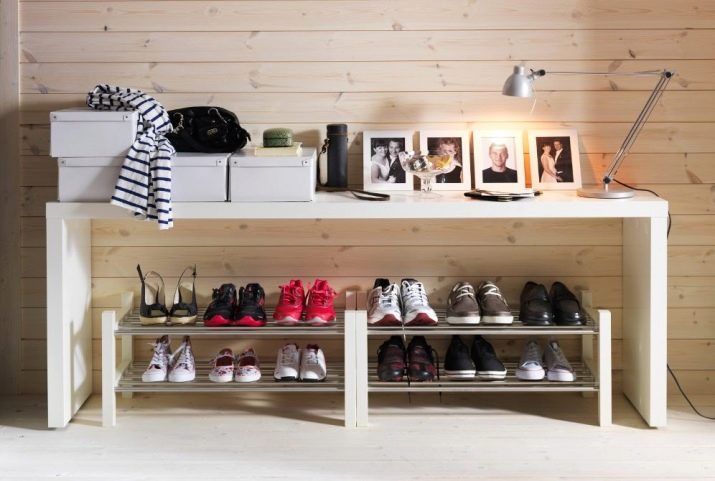
How to make an original stand for shoes in the hallway with your own hands, see the next video.
